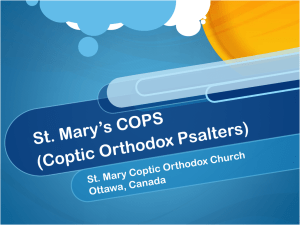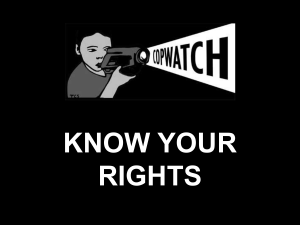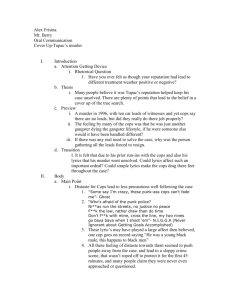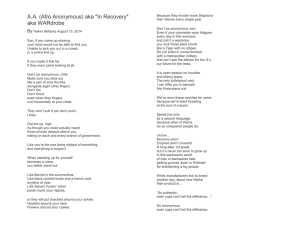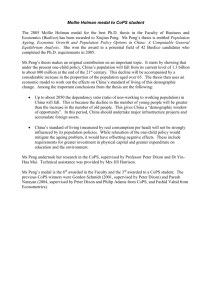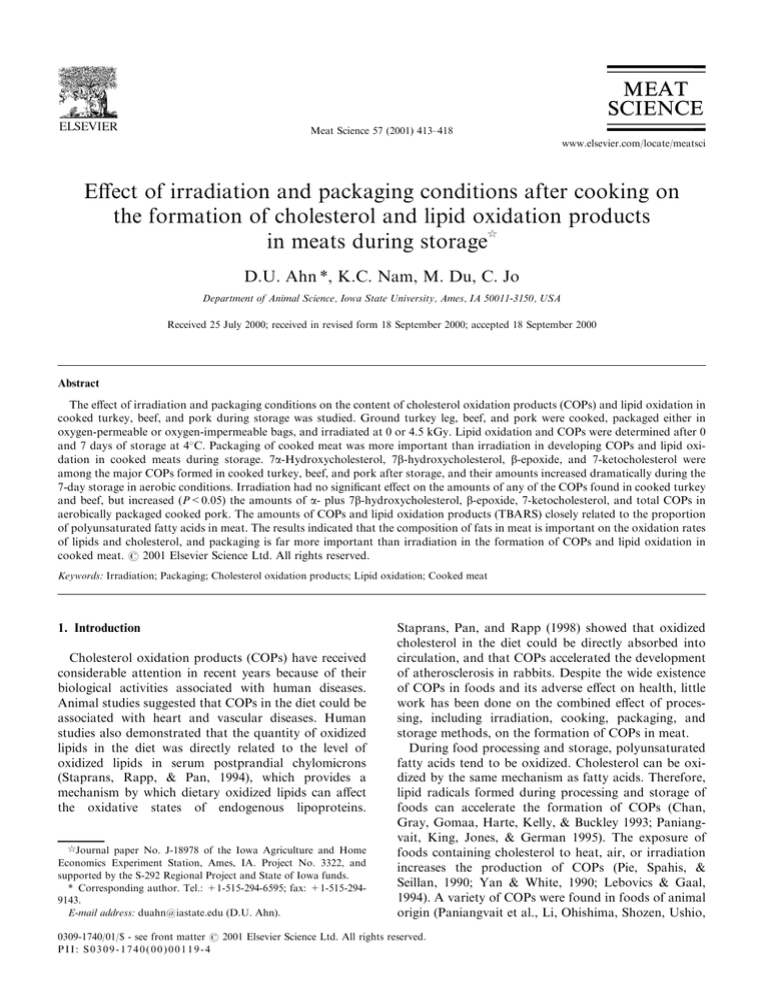
Meat Science 57 (2001) 413±418
www.elsevier.com/locate/meatsci
Eect of irradiation and packaging conditions after cooking on
the formation of cholesterol and lipid oxidation products
in meats during storage
$
D.U. Ahn *, K.C. Nam, M. Du, C. Jo
Department of Animal Science, Iowa State University, Ames, IA 50011-3150, USA
Received 25 July 2000; received in revised form 18 September 2000; accepted 18 September 2000
Abstract
The eect of irradiation and packaging conditions on the content of cholesterol oxidation products (COPs) and lipid oxidation in
cooked turkey, beef, and pork during storage was studied. Ground turkey leg, beef, and pork were cooked, packaged either in
oxygen-permeable or oxygen-impermeable bags, and irradiated at 0 or 4.5 kGy. Lipid oxidation and COPs were determined after 0
and 7 days of storage at 4 C. Packaging of cooked meat was more important than irradiation in developing COPs and lipid oxidation in cooked meats during storage. 7a-Hydroxycholesterol, 7b-hydroxycholesterol, b-epoxide, and 7-ketocholesterol were
among the major COPs formed in cooked turkey, beef, and pork after storage, and their amounts increased dramatically during the
7-day storage in aerobic conditions. Irradiation had no signi®cant eect on the amounts of any of the COPs found in cooked turkey
and beef, but increased (P<0.05) the amounts of a- plus 7b-hydroxycholesterol, b-epoxide, 7-ketocholesterol, and total COPs in
aerobically packaged cooked pork. The amounts of COPs and lipid oxidation products (TBARS) closely related to the proportion
of polyunsaturated fatty acids in meat. The results indicated that the composition of fats in meat is important on the oxidation rates
of lipids and cholesterol, and packaging is far more important than irradiation in the formation of COPs and lipid oxidation in
cooked meat. # 2001 Elsevier Science Ltd. All rights reserved.
Keywords: Irradiation; Packaging; Cholesterol oxidation products; Lipid oxidation; Cooked meat
1. Introduction
Cholesterol oxidation products (COPs) have received
considerable attention in recent years because of their
biological activities associated with human diseases.
Animal studies suggested that COPs in the diet could be
associated with heart and vascular diseases. Human
studies also demonstrated that the quantity of oxidized
lipids in the diet was directly related to the level of
oxidized lipids in serum postprandial chylomicrons
(Staprans, Rapp, & Pan, 1994), which provides a
mechanism by which dietary oxidized lipids can aect
the oxidative states of endogenous lipoproteins.
$
Journal paper No. J-18978 of the Iowa Agriculture and Home
Economics Experiment Station, Ames, IA. Project No. 3322, and
supported by the S-292 Regional Project and State of Iowa funds.
* Corresponding author. Tel.: +1-515-294-6595; fax: +1-515-2949143.
E-mail address: duahn@iastate.edu (D.U. Ahn).
Staprans, Pan, and Rapp (1998) showed that oxidized
cholesterol in the diet could be directly absorbed into
circulation, and that COPs accelerated the development
of atherosclerosis in rabbits. Despite the wide existence
of COPs in foods and its adverse eect on health, little
work has been done on the combined eect of processing, including irradiation, cooking, packaging, and
storage methods, on the formation of COPs in meat.
During food processing and storage, polyunsaturated
fatty acids tend to be oxidized. Cholesterol can be oxidized by the same mechanism as fatty acids. Therefore,
lipid radicals formed during processing and storage of
foods can accelerate the formation of COPs (Chan,
Gray, Gomaa, Harte, Kelly, & Buckley 1993; Paniangvait, King, Jones, & German 1995). The exposure of
foods containing cholesterol to heat, air, or irradiation
increases the production of COPs (Pie, Spahis, &
Seillan, 1990; Yan & White, 1990; Lebovics & Gaal,
1994). A variety of COPs were found in foods of animal
origin (Paniangvait et al., Li, Ohishima, Shozen, Ushio,
0309-1740/01/$ - see front matter # 2001 Elsevier Science Ltd. All rights reserved.
PII: S0309-1740(00)00119-4
414
D.U. Ahn et al. / Meat Science 57 (2001) 413±418
and Koizumi (1994) showed that the formation of COPs
was accelerated by polyunsaturated fatty acids present in
lipids. Because meats from dierent animal species have
dierent fatty acid composition, the rates of COPs formation can also be dierent. However, little information is
available about COPs formation in meats from dierent
animal species.
Ionizing radiation has been used in food processing to
control microbial growth (Farkas, 1998). Ionizing radiation induces oxidation, and the quantity of oxidation
products formed by irradiation increased in a dosedependent manner (Lebovics, Gaal, Somagyi, & Farkas
1992). Hwang and Maerker (1993a) reported that irradiation of raw beef, pork and veal at 10 kGy increased the
contents of COPs, and the increases of COPs in those
meats during storage were greater in the irradiated than
in the nonirradiated. Du and Ahn (2000) reported that
radiation increased the formation of COPs in egg yolk
powder, and the presence of oxygen had a signi®cant
eect on the rate of formation. Cooked meat is very
susceptible to oxidative change because of the destruction of phospholipid membrane structure by heat denaturation (Ahn, Olson, Lee, Jo, Chen, & Wu 1998). Lipid
oxidation in cooked meat was accelerated under aerobic
conditions during storage. Therefore, signi®cant
amounts of COPs can be formed if irradiation, cooking,
and storage in aerobic packaging are combined.
The objective of this study was to determine the eect
of irradiation and packaging on the content of COPs in
cooked turkey, beef, and pork during storage.
2. Materials and methods
2.1. Sample preparation
Turkey leg, beef loin, and pork loin muscles, purchased from four local supermarkets, were trimmed of
all fat from the surface, the lean muscles were ground
separately through a 3-mm plate, and patties (approximately 100 g each) were prepared. Meats from each
supermarket were used as a replication. Patties were
individually packaged in oxygen-permeable zipper bags
(46, 2 MIL, Associated Bag Company, Milwaukee,
WI), stored overnight at 4 C and cooked in bags in an
85 C water bath for 25 min. After cooling for 30 min at
room temperature and draining meat juice o from the
bag, the meat patties were repackaged either in polyethylene oxygen-permeable bags or nylon/polyethylene
vacuum bags (O2 permeability, 9.3 mL O2/m2/24 h at
0 C; Koch, Kansas City, MO). After packaging, patties
were stored overnight at 4 C and then irradiated at
ambient temperature at 0 or 4.5 kGy using a linear
accelerator (Circe IIIR, Thomson CSF Linac, SaintAubin, France). The energy and power levels used were
10 MeV and 10 kw, respectively, and the average dose
rate was 91.3 kGy/min. The max/min ratio was approximately 1.20 for 4.5 kGy. To con®rm the target dose, two
alanine dosimeters per cart were attached to the top and
bottom surfaces of the sample. The alanine dosimeter
was read using a 104 Electron Paramagnetic Resonance
Instrument (Bruker Instruments, Inc., Billerica, MA).
All samples were stored at 4 C for up to 7 days, and
COPs and lipid oxidation in cooked meat were analyzed
after 0 and 7 days of storage at 4 C. Lipid oxidation
was determined by the ¯uorometric thiobarbituric acid
reactive substances (TBARS) method of Jo and Ahn
(1998).
2.2. Preparation of COPs
Lipids were extracted from samples according to the
method of Folch, Lees, and Sloan-Stanley (1957). Five
grams of meat sample, butylated hydroxytoluene (50 ml,
7.2%), and 30 ml Folch 1 solution (chloroform: methanol=2:1) were added to a 50-ml test tube and homogenized using a Polytron (Brinkman Instruments, Inc.,
Westbury, NY) for 20 s at high speed. The homogenate
was ®ltered through a Whatman No. 1 ®lter paper
(Whatman Inc., Clifton, NJ) into a 100-ml graduated
cylinder, and the ®lter paper was rinsed twice with 10 ml
of Folch 1 solution. After addition of 8 ml of 0.88%
NaCl solution to each cylinder, the cylinder was capped
with a glass stopper and the content mixed. The inside of
the cylinder was washed twice with 5 ml of Folch 2 solution (chloroform: methanol: water=3:47:48). After
phase separation, the lipid layer volume was recorded,
and the upper layer (methanol and water) of the solution
was completely and carefully siphoned o to prevent
contamination of the chloroform layer. The organic
layer was put in a glass scintillation vial and dried in a
block heater for 1 h at 50 C. The dried lipid was dissolved with an aliquot of hexane (with 2 drops of ethanol
to improve the solubility of polar lipids) to make 0.1 g
fat/ml hexane and used for the fatty acid and cholesterol
analysis.
A silicic acid (100 mesh), cellite-545, and CaHPO.4
2H2O (10:9:1, w/w/w) mixture in chloroform was prepared and packed into a glass column (22 mm30 cm
with a sintered glass frit at the bottom) to a height of 10
cm. The column was washed with 10 ml of Solvent I
(hexane: ethyl acetate=9:1, v/v) before a sample was
loaded. Lipid sample dissolved in hexane (0.2 g) was
loaded onto the silicic acid column. Neutral lipids, cholesterol, and phospholipids were eluted by passing 40 ml
of Solvent II (hexane: ethyl acetate=4:1, v/v) through
the column. Then COPs were eluted with 40 ml of Solvent III (acetone: ethyl acetate: methanol=10:10:1, v/v/
v) and dried under nitrogen. The dried COPs were
added with 200 ml pyridine and 100 ml bis-trimethylsilyltri¯uoroacetamide+1% trimethylchlorosilane and
derivatized by heating in a dry bath (80 C) for 1 h.
D.U. Ahn et al. / Meat Science 57 (2001) 413±418
2.3. Gas chromatograph (GC) analysis of COPs
COPs were analyzed as described by Ahn, Lee, Jo,
and Sell (1999) after 0 and 7 days of storage at 4 C.
Analysis of COPs was performed with an HP 6890 GC
(Hewlett Packard Co., Wilmington, DE) equipped with
an on-column capillary injector and ¯ame ionization
detector (FID). An HP-5 capillary column of 0.25 mm
i.d.30 m bonded phase 5% phenylsilicon with 0.25-mm
®lm thickness (Hewlett Packard Co.) was used. A splitless inlet was used to inject samples (0.5 ml) into the
capillary column, and a ramped oven temperature was
used (80 C for 0.25 min, increased to 230 C at 40 C /
min, increased to 270 C at 25 C /min, increased to
285 C at 1.5 C/min, and held for 8 min). Temperatures
of both the inlet and detector were 280 C. Helium was
the carrier gas at constant pressure of 18.5 psi. Detector
(FID) air, H2, and make-up gas (He) ¯ows were 300, 30,
and 28 mL/min, respectively. The area of each peak
(pAs) was integrated using the Chemstation software
(Hewlett Packard Co.), and the amount of COPs was
calculated using an internal standard.
2.4. GC analysis of fatty acid composition
Fatty acid pro®les of three meat species were determined by the method of Du and Ahn (2000). One milliliter of methylating reagent (boron-tri¯uoride methanol,
Sigma Chemical Co.) was added to 50 ml of the lipid
extract and incubated in a 90 C water bath for 1 h.
After cooling to room temperature, 2 ml hexane and 5
ml water were added, mixed thoroughly, and left at
room temperature overnight for phase separation. The
top hexane layer containing methylated fatty acids was
analyzed for fatty acid composition using a GC (HP
6890; Hewlett Packard Co.). An HP-5 (5%-diphenyl95%-dimethylsiloxane copolymer) capillary column
(Hewlett Packard Co.) of 0.32 mm i.d.30m with 0.25mm ®lm thickness was used. A splitless inlet was used to
inject samples (1 ml) into the capillary column. A
ramped oven temperature condition (180 C for 2.5 min,
415
increased to 230 C at 2.5 C/min, then held at 230 C for
7.5 min) was used. Temperatures of both the inlet and
detector were 280 C. Helium was the carrier gas at linear
¯ow of 1.1 ml/min. Detector (FID) air, H2, and make-up
gas (He) ¯ows were 350, 35, and 43 ml/min, respectively. Fatty acids were identi®ed by comparison of
retention times to known standards. Relative quantities
were expressed as weight percentage of total fatty acids.
2.5. Statistical analysis
The experimental design was to determine the eects of
irradiation, packaging conditions, and storage on lipid
oxidation and cholesterol oxidation. Data were analyzed
using SAS software (SAS Institute, 1985) by the generalized linear model procedure, and the Student-Newman-Keuls' multiple range test was used to compare
dierences among means. Mean values and standard
error of the means were reported. Signi®cance was de®ned
at P<0.05.
3. Results and discussion
At Day 0, vacuum-packaged cooked turkey meat produced more 7-ketocholesterol than aerobically packaged
irradiated and nonirradiated meat. However, the
amounts of other COPs, including total COPs, in cooked
meat were not in¯uenced by irradiation and packaging
during and after irradiation (Table 1). The amounts of
total COPs in vacuum-packaged cooked turkey meat
increased about two-fold, and those of aerobically
packaged increased about 10-fold after 7 days of storage. Among the COPs, 7a-hydroxycholesterol, 7bhydroxycholesterol, b-epoxide, and 7-ketocholesterol
were among the major COPs produced in cooked turkey
meat, and their amounts increased dramatically during
the 7-day storage in aerobic conditions. But, irradiation
had no eect on the amounts of any of the COPs found
in cooked turkey meat. Hwang and Maerker (1993b)
reported that irradiation of raw chicken meat at 10 kGy
Table 1
The content of cholesterol oxidation products (COPs) in cooked turkey leg meat with dierent irradiation, packaging, and storage conditionsa
COPs
7a- and 7b-Hydroxycholesterol
a-Epoxide
b-Epoxide
20a-Hydroxycholesterol
Cholestantriol
7-Ketocholesterol
Total
a
Day 0 (mg COPs/g lipid)
Day 7 (mg COPs/g lipid)
V-C
V-IR
A-C
A-IR
S.E.M.
V-C
55.2
1.0
1.0
1.6
0.6
14.2a
73.4
57.5
3.1
0.8
2.6
0
9.5 a,b
73.4
47.5
1.0
0
0
0
5.4 b
53.8
37.0
1.6
0
1.0
0.8
4.9 b
45.1
7.6
1.1
0.6
1.0
0.4
1.7
10.0
101.4
13.2
7.6
0.8
0.5
36.8
160.1
V-IR
b
b
b
b
b
68.4
15.9
7.6
2.2
1.0
26.2
125.0
A-C
c
b
b
b
b
298.4
16.1
61.4
3.1
5.3
183.5
568.1
A-IR
a
a
a
a
a
266.2
8.5
55.7
4.9
2.3
157.0
494.5
S.E.M.
a
a
b
a
a
20.9
2.0
6.4
2.2
0.6
13.9
39.3
Sampled 2 h after cooking. Values with dierent letters within a row of the same storage time are dierent (P<0.05). A, aerobic packaging; V,
vacuum packaging; C, nonirradiated control; IR, irradiated at 4.5 kGy dose; S.E.M., standard error of the mean.
416
D.U. Ahn et al. / Meat Science 57 (2001) 413±418
As in turkey meat, a- plus 7b-hydroxycholesterol and
7-ketocholesterol were the major COPs in cooked pork
at Day 0 (Table 3). The amounts of a- plus 7b-hydroxycholesterol and total COPs in aerobically packaged
cooked pork were higher than those of the vacuumpackaged pork at Day 0, but irradiation had no eect
on the content of COPs in cooked pork. After 7 days of
storage, aerobically packaged pork produced 10- to 15fold higher amounts of total COPs than the vacuumpackaged pork. Irradiation signi®cantly increased the
amounts of a- plus 7b-hydroxycholesterol, b-epoxide, 7ketocholesterol, and total COPs in aerobically packaged
cooked pork.
Table 4 indicates that packaging of cooked meat is
more important than irradiation on the development of
lipid oxidation in cooked meats during storage. With
vacuum packaging, all meats except irradiated cooked
turkey showed little changes in TBARS during the 7-day
storage. With aerobic packaging, three to ®ve-fold
increases in TBARS were observed in all cooked meats.
Irradiation decreased the TBARS of vacuum- and aerobically packaged cooked turkey meat at Day 0 and
aerobically packaged turkey and beef at Day 7. The
TBARS of cooked turkey meat was the highest, beef was
the lowest, and pork was intermediate at both Day 0
and Day 7.
increased the content of 6-ketoxholestanol to about four
times the level of nonirradiated chicken. However, no 6ketoxholestanol was detected in the irradiated cooked
turkey in this study.
The composition of COPs in cooked beef at Day 0 was
quite dierent from that of the cooked turkey where 7aplus 7b-hydroxycholesterol and 7-ketocholesterol were
the major COPs. The amounts of a- and b-epoxides, 20ahydroxycholesterol, and triol found in cooked beef were
greater than those of the cooked turkey at Day 0. The
eects of packaging and/or irradiation on the contents of
COPs were not consistent (Table 2). After 7 days of storage, signi®cant increases in 7a- plus 7b-hydroxycholesterol and 7-ketocholesterol were observed in beef
with aerobic packaging. Total COPs also increased in
cooked beef after 7 days of storage in aerobic conditions.
However, other COPs such as a-epoxide, b-epoxide, 20ahydroxycholesterol, and triol remained unchanged or
decreased after 7 days of storage, especially with vacuum
packaging. Hwang and Maerker (1993a) reported that
irradiation of raw beef and pork increased the content
of COPs. However, irradiation had no eect on the formation of COPs in cooked beef as in cooked turkey meat
(Tables 1 and 2). The decrease of COPs in vacuumpackaged cooked beef after 7 days of storage cannot be
explained.
Table 2
The content of cholesterol oxidation products (COPs) in cooked pork with dierent irradiation, packaging, and storage conditionsa
COPs
7a- and 7b-Hydroxycholesterol
a-Epoxide
b-Epoxide
20a-Hydroxycholesterol
Cholestantriol
7-Ketocholesterol
Total
Day (mg COPs/g lipid)
Day 7 (mg COPs/g lipid)
V-C
V-IR
A-C
A-IR
S.E.M.
V-C
13.9
6.8
8.0
15.9 a
4.9 a,b
12.6 a,b
61.9
14.9
10.8
9.8
8.4 b
3.4 b
9.5 b
56.8
15.3
8.1
9.6
5.2 b
5.0 a,b
20.1 a
63.2
19.0
11.7
7.3
5.2 b
6.2 a
19.2 a
68.5
3.1
2.9
1.2
1.1
0.7
2.4
6.3
15.1
17.0
0
0b
0b
11.7
43.8
b
a
b
b
V-IR
A-C
13.7b
3.3 b
0
4.4 a
0b
7.3 b
28.6 b
108.6
4.7
3.6
3.9
4.0
45.6
170.4
a
b
a
a
a
a
A-IR
S.E.M.
88.7 a
7.7 b
4.2
3.1a
4.2 a
44.8 a
152.7 a
7.7
1.7
1.5
0.9
0.6
5.5
12.4
a
Sampled 2 h after cooking. Values with dierent letters within a row of the same storage time are dierent (P<0.05). A, aerobic packaging; V,
vacuum packaging; C, nonirradiated control; IR, irradiated at 4.5 kGy dose; S.E.M., standard error of the mean.
Table 3
The content of cholesterol oxidation products (COPs) in cooked beef with dierent irradiation, packaging and storage conditionsa
COPs
7a- and 7b-Hydroxycholesterol
a-Epoxide
b-Epoxide
Cholestantriol
7-Ketocholesterol
Total
a
Day 0 (mg COPs/g lipid)
Day 7 (mg COPs/g lipid)
V-C
V-IR
A-C
A-IR
S.E.M.
V-C
14.0 b
5.5
2.8
0
7.6
29.9 a,b
11.0 b
3.0
1.5
1.3
8.4
25.2 b
26.3 a
5.0
2.6
0.7
15.3
49.8 a
27.5 a
4.6
1.8
0.6
8.1
42.5 a
2.9
1.0
0.5
0.8
3.0
5.6
7.9
1.7
0b
1.5
3.0
14.0
c
b
c
c
V-IR
A-C
7.3
2.4
4.6
2.2
5.9
22.3
113.6
16.2
7.3
2.5
112.6
252.2
c
b
b
c
c
A-IR
b
a
b
a
b
150.9
17.1
37.8
3.7
164.2
373.6
S.E.M.
a
a
a
c
a
9.2
0.9
2.2
1.4
7.5
17.3
Sampled 2 h after cooking. Values with dierent letters within a row of the same storage time are dierent (P<0.05). A, aerobic packaging; V,
vacuum packaging; C, nonirradiated control; IR, irradiated at 4.5 kGy dose; S.E.M., standard error of the mean.
D.U. Ahn et al. / Meat Science 57 (2001) 413±418
417
Table 4
Eect of irradiation, storage, and packaging conditions on TBARS values of cooked turkey leg, beef, and porka
Treatment
TBARS (mg MDA/kg meat)
Turkey meat
V-C
V-IR
A-C
A-IR
S.E.M.
Beef
Pork
Day 0
Day 7
S.E.M.
Day 0
Day 7
S.E.M.
Day 0
Day 7
S.E.M.
3.95
2.86
3.55
2.85
0.18
4.44
3.63
10.87
8.95
0.35
0.05
0.12
0.13
0.23
0.95
0.90
0.98y
0.95y
0.16
1.00
0.91
5.06
3.69
0.31
0.20
0.20
0.28
0.29
1.43
1.13
2.82
2.29
0.19
1.71
0.97
6.95
5.58
0.66
0.08
0.08
0.73
0.63
a,y
b,y
a,y
b,y
c,x
c,x
a,x
b,x
c
c
a,x
b,x
b,y
b
a,y
a,y
b,x
b
a,x
a,x
a
Sampled 2 h after cooking. Dierent letters (a±c) within a column of the same storage time are signi®cantly dierent (P<0.05). Values with
dierent letters (x and y) within a row of the same meat are dierent (P <0.05). A, aerobic-packaging; V, vacuum-packaging; C, nonirradiated
control; IR, irradiated at 4.5 kGy dose; S.E.M., standard error of the mean
Because polyunsaturated fatty acids tended to be oxidized by a free radical mechanism, the oxidation rates of
lipids and cholesterol for those dierent meats were
in¯uenced by the composition of fats in meat as reported by Li, Ahn, Cherian, Chung, and Sim (1996). The
total fat contents of turkey meat, pork and beef were
6.65, 8.27 and 9.38%, respectively. The fatty acid compositions of meats from the three animal species showed
that turkey meat contained 26.16% of linoleic and
4.02% of arachidonic acid, pork had 16.96% of linoleic
and 3.26% of arachidonic acid, and beef had 5.19% of
linoleic and 1.19% of arachidonic acid. The TBARS of
meats correlated well with the proportions of polyunsaturated fatty acids and amounts of total COPs in
meat, and were in good agreement with those of others
(Angulo, Romero, Ramirez, & Gil 1997; Galvin, Morrissey, & Buckley, 1998).
4. Conclusion
Large amounts of COPs can be formed in meat after
cooking and storage. Packaging was far more important
than irradiation in the formation of COPs and lipid oxidation in cooked meat. The COPs produced in turkey,
beef, and pork during cooking and storage were mainly
7a-hydroxycholesterol, 7b-hydroxycholesterol, and 7ketocholesterol, which have signi®cant health implications because these COPs can be absorbed in guts and
are directly associated with the initiation and development of atherosclerosis in animals (Lyons, Samman,
Gatto, & Brown 1999; Vine, Mamo, Beilin, Mori, &
Croft 1998).
References
Ahn, D. U., Olson, D. G., Lee, J. I., Jo, C., Chen, X., & Wu, C.
(1998). Packaging and irradiation eects on lipid oxidation and
volatiles in pork patties. Journal of Food Science, 63, 15±19.
Ahn, D. U., Lee, J. I., Jo, C., & Sell, J. L. (1999). Analysis of cholesterol
oxides in egg yolk and turkey meat. Poultry Science, 78, 1060±1064.
Angulo, A. J., Romera, J. M., Ramirez, M., & Gil, A. (1997). Determination of cholesterol oxides in dairy products. Eect of storage
conditions. Journal of Agricultural and Food Chemistry, 45, 4318±
4323.
Chan, S. H., Gray, J. I., Gomaa, E. A., Harte, B. R., Kelly, P. M., &
Buckley, D. J. (1993). Cholesterol oxidation in whole milk powders
as in¯uenced by processing and packaging. Food Chemistry, 47,
321±328.
Du, M. & Ahn, D. U. (2000). Eects of antioxidants and packaging on
lipid and cholesterol oxidation and color changes of irradiated egg
yolk powder. Journal of Food Science, (in press)
Farkas, J. (1998). Irradiation as a method for decontaminating food.
International Journal of Food Microbiology, 44, 189±204.
Folch, J., Lees, M., & Sloan-Stanley, G. H. (1957). A simple method
for the isolation and puri®cation of total lipids from animal tissues.
Journal of Biological Chemistry, 226, 497±507.
Galvin, K., Morrissey, P. A., & Buckley, D. J. (1998). Eect of dietary
alpha-tocopherol supplement and gamma-irradiation on alphatocopherol retention and lipid oxidation in cooked minced chicken.
Food Chemistry, 62, 185±190.
Hwang, K. T., & Maerker, G. (1993a). Quantitation of cholesterol
oxidation products in unirradiated and irradiated meats. Journal of
American Oil Chemists' Society, 70(4), 371±375.
Hwang, K. T., & Maerker, G. (1993b). Determination of 6-ketocholestanol in unirradiated and irradiated chicken meats. Journal of
American Oil Chemists' Society, 70(4), 789±792.
Jo, C., & Ahn, D. U. (1998). Use of ¯uorometric analysis of 2-thiobarbituric acid reactive substances in meat. Poultry Science, 77,
475±480.
Lebovics, V. K., & Gaal, O. (1994). In¯uence of packaging atmosphere on the formation of cholesterol oxides in g-irradiated egg
powder. Journal of the Science of Food and Agriculture, 66, 71±73.
Lebovics, V. K., Gaal, O., Somogyi, L., & Farkas, J. (1992). Cholesterol oxides in g-irradiated spray-dried egg powder. Journal of the
Science of Food and Agriculture, 60, 251±254.
Li, N., Ohshima, T., Shozen, K. I., Ushio, H., & Koizumi, C. (1994).
Eects of the degree of unsaturation of coexisting triacylglycerols
on cholesterol oxidation. Journal of the American Oil Chemists
Society, 71, 623±627.
Li, S. X., Ahn, D. U., Cherian, G., Chung, T. Y., & Sim, J. S. (1996).
Dietary oils and tocopherol supplementation on cholesterol oxide
formation in freeze-dried chicken meat during storage. Journal of
Food Lipids, 3, 27±42.
Lyons, M. A., Samman, S., Gatto, L., & Brown, A. J. (1999). Rapid
hepatic metabolism of 7-ketocholesterol in vivo: Implications for
dietary oxysterols. Journal of Lipid Research, 40, 1846±1857.
Paniangvait, P., King, A. J., Jones, A. D., & German, B. G. (1995).
Cholesterol oxides in foods of animal origin. Journal of Food
Science, 60, 1159±1174.
418
D.U. Ahn et al. / Meat Science 57 (2001) 413±418
Pie, J. E., Spahis, K., & Seillan, C. (1990). Evaluation of oxidative
degradation of cholesterol in food and food ingredients: Identi®cation and quanti®cation of cholesterol oxides. Journal of Agricultural
and Food Chemistry, 38, 973±979.
SAS1 Institute, Inc (1985). SAS user's guide. Cary, NC: SAS Institute.
Staprans, I., Pan, X. M., & Rapp, J. H. (1998). Oxidized cholesterol in
the diet accelerates the development of aortic atherosclerosis in
cholesterol-fed rabbits. Arteriosclerosis, Thrombosis, and Vascular
Biology, 18, 977±983.
Staprans, I., Rapp, X. M., & Pan, X. M. (1998). Oxidized lipids in the
diet are a source of oxidized lipid in chylomicrons of human serum.
Arteriosclerosis and Thrombosis, 14, 1900±1905.
Vine, D. F., Mamo, C. L., Beilin, L. J., Mori, T. A., & Croft, K. D.
(1998). Dietary oxysterols are incorporated in plasma triglyceriderich lipoproteins, increase their susceptibility to oxidation and
increase aortic cholesterol concentration of rabbits. Journal of Lipid
Research, 39, 1995±2004.
Yan, P. S., & White, P. J. (1990). Cholesterol oxidation in heated lard
enriched with two levels of cholesterol. Journal of the American Oil
Chemists Society, 67, 927±931.

